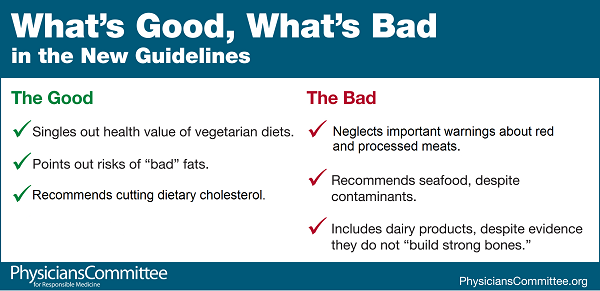Digesting the 2015 Dietary Guidelines

Americans have endured a dietary dilemma that began with the February 2015 release of the Scientific Report of the 2015 Dietary Guidelines Advisory Committee. What foods promote good health? Which cause disease? We’ve spent the last year trying to clear up the confusion. The 2015 Dietary Guidelines for Americans that were released this morning also attempt to answer those questions. Here’s my breakdown of what the Guidelines get right and wrong.
Plant-Based Diets
The most heartening news is that the Guidelines continue to push the power of plant-based diets to fight disease. The Guidelines recommended Healthy Vegetarian Pattern—including an entirely vegan plan—and note that this pattern is higher in calcium and fiber than the Healthy U.S.-Style Pattern, which includes animal products.
Cholesterol and Saturated Fat
More good news: The Guidelines strengthen cholesterol warnings by urging Americans to “eat as little dietary cholesterol as possible” to help reduce risk of heart disease, obesity, and other conditions. The decision follows our yearlong campaign—including petitions, oral testimony, billboards, and threat of legal action—to stop industry’s efforts to remove cholesterol warnings from the Guidelines.
But in urging Americans to cut the cholesterol, the Guidelines should not have recommended cholesterol-containing seafood, lean meats and poultry, and eggs as part of a healthy eating pattern. All animal products contain cholesterol. In their defense, the Guidelines do limit meat, poultry, and eggs—all combined—to just 4 ounces per day, or even less for some groups. So it’s a step forward.
The Guidelines also recommend limiting saturated fat, but again cause confusion by recommending meat and dairy products—the leading sources of saturated fat in the American diet.
Red and Processed Meats
Again, there’s good and bad news. First the good: The Guidelines urge “teen boys and adult men … to reduce overall intake of protein foods … by decreasing intakes of meats, poultry, and eggs.” And the “protein foods” group includes healthful foods—legumes, nuts, seeds, and soy products.
But the bad news—and it’s really bad—is that the Guidelines actually encourage everyone else to eat processed meats: “For those who eat animal products, the recommendation for the protein foods … can be met by consuming a variety of lean meats, lean poultry, and eggs. Choices within these eating patterns may include processed meats and processed poultry…”
This recommendation blatantly ignores the dire health consequences of consuming processed meats, carcinogens that the World Health Organization recently placed in the same category as cigarettes and asbestos. A recent study in Lancet Oncology observed associations between red and processed meat products and colon, stomach, pancreatic, and prostate cancers.
Dairy Products
The Guidelines should have also ditched the dairy recommendations to help Americans cut down on sugar and reduce the risk for hip fractures, prostate cancer, and early death. However, the Guidelines did say that soy milk counts as a dairy product, so that is a step forward.
What’s Next?
We were able to keep industry from influencing cholesterol recommendations, but industry fingerprints are all over the Guidelines, from what’s included (recommendations for lean meat) to what’s missing (sustainability). In 2016, we’re continuing our legal efforts to find out how the Dietary Guidelines Advisory Committee could be so easily swayed by industry.







